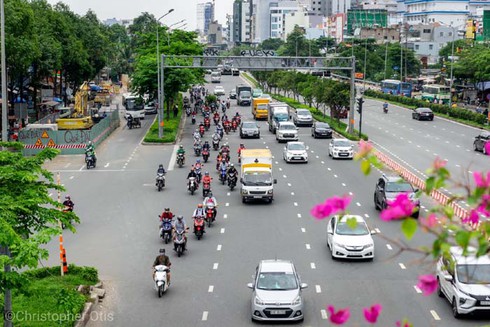he describes living in a metaphorical bubble of safety while much of the world continues to suffer from this novel coronavirus (COVID-19).
 |
| The streets of Ho Chi Minh City have come roaring back to life after Vietnam’s successful fight against COVID-19. (June 9, 2020) (Photo: Christopher Otis) |
“67 days. It’s been 67 days (as of publishing) since the last confirmed case of community transmission of COVID-19 in Vietnam, a country of nearly 100 million people that shares a 1444-km border with China, its neighbour with which it has, for all its political and social complications, an extremely active and productive trade and economic relationship”, Christopher Otis wrote to start his article published on the website medium.com on June 22.
He has been able to witness some of the efforts to fight the COVID-19 first hand in recent months, with the American hoping that the rest of the world will be able to learn some valuable lessons on how this amazing country has been able to be successful to handle the pandemic.
According to Christopher Otis, his home country of the United States is on average recording 20,000 to 30,000 new confirmed cases each day, meaning that a new infection is occurring somewhere in the country between every three to four seconds.
“Every day I wake up experiencing a cocktail of emotions ranging from anxiety and worry about my at-risk family members,” Otis shared.
Regarding the nation’s fight against the virus, he wrote, “Zero deaths. For those of you outside of Vietnam, it’s hard to sum up just how sensationally the country has handled this pandemic. With a national healthcare budget that’s a mere fraction of that of the US, Vietnam has managed to keep the number of infections extremely low.”
Otis goes on to point out the miracle behind the nation’s COVID-19 success, “Even more remarkably, Vietnam has prevented even a single death from occurring due to COVID-19, an incredible statistic surely made possible by a bit of good fortune, but even more so by an extremely well-organised and well-executed government response that successfully limited the number of active infections in the country.”
The American details his shock at the rapid response of the Vietnamese government once cases of the virus were confirmed, with swift moves to close schools across the entire country, which essentially extended the Tet, Lunar New Year, holiday for a few additional weeks.
The article also describes some of the effective measures implemented to halt the spread of the epidemic, such as closing borders, mandatory quarantine for those who came into contact with confirmed cases, along with unprecedented transparency and communication from the government. These policies came simultaneously alongside the closure of non-essential businesses and a ban on public gatherings, with no more than two people able to meet throughout the month of April, with Otis noting, “the spread of COVID-19 in Vietnam never really took off as it did in much of the rest of the world.”
“It’s hard to overstate the strangeness of the feeling that results from hearing updates on the situation in the US and around the world, and then hopping on my motorbike and driving into the city to go to work and stand in front of 20 mask-less students, or going to a non-socially-distanced coffee shop or bar, or even simply looking outside and seeing life go on as it did six months ago before this all happened,” Otis said.
“I was actually in the United States at the end of January when the pandemic had begun to make international headlines, and I had to wonder to myself if flying back to Asia at the beginning of February was really a good idea. Of course, it turned out to be the best idea,” he added.
To conclude his thoughts, Otis states his belief that, “Vietnam, against long odds, has become one of the best and safest places to be during this pandemic.” VOV